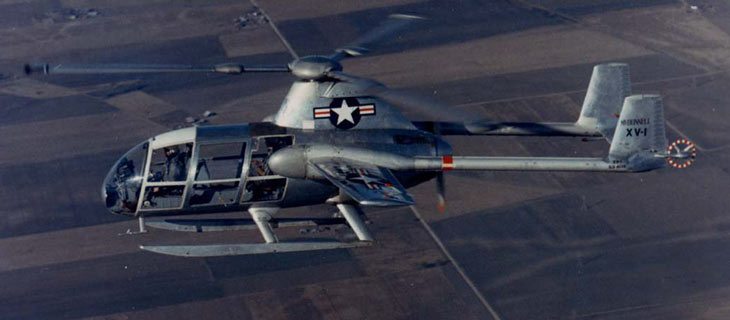McDonnell
XV-1 Convertiplane
The McDonnell XV-1 Convertiplane was developed through a joint
program between the United States Army and Air Force. It was designed
to assess the viability of a niche aircraft variant called a compound
gyroplane. It was able to take off and land like a helicopter, but
had a significantly higher top speed than any rotorcraft of the time.
The McDonnell XV-1 Convertiplane was a development of a concept design
submitted to the US Army and Air Force to fulfill a brief which called
for a VTOL aircraft which could cruise faster than conventional helicopters.
Bell Aircraft and Sikorsky also entered their designs, but it was
the Model M-28 from McDonnell (which developed into the XV-1) which
won.
After being awarded a contract to develop the design in June 1951,
McDonnell were able to create a full-size mockup for inspection by
the Army and Air Force in five months. It took just under 2 years
more before the first prototype was ready for flight testing in early
1954.

The McDonnell XV-1 was primarily constructed from Aluminium. It had
a streamlined fuselage which had exellent visibility for the pilot
and passengers thanks to large Plexiglas windows all round. Behind
the passenger compartment was space for the Continental R-975 radial
piston engine which powered twin air compressors. The compressors
pumped air via ducts to the main rotor for vertical flight, while
the engine drove the two-bladed pusher propeller at the rear of the
fuselage for horizontal flight. During forward flight the stubby wings
provided 80 percent of the lift with the remainder generated by the
main rotor autorotating at about 50 percent of normal rpm.
The McDonnell XV-1 Convertiplane had space for four seated occupants
(including pilot), or it could carry two stretchers and a pilot.
Results of early test flights showed there were issues with the rotor's
tip-jet propulsion system and also excessive drag from the tall rotor
pylon. The second prototype was redesigned to overcome these problems.
The pylon was lowered, and the undercarriage streamlined. In addition
two small tail rotors were mounted to the outboard side at the end
of each tailboom. These were added to improve yaw control, and were
also retrofitted to the first prototype.
The second prototype flew in 1955, and later that year became the
first rotorcraft to exceed 200 mph, nearly 45 mph faster than the
helicopter speed record of the time.
Utimatley, the XV-1 Convertiplane program was canceled in 1957. The
design was considered to be too complex to make up for the small advantages
it provided, and conventional helicopter design was rapidy improving
leading to ever smaller performance margins. The final nail in the
coffin for the XV-1 however was the noise produced by the rotor's
tip-jet system. It was 116dB in the cockpit, and even louder for ground
personnel - who also described the noise as "extremely irritating".
Even at half a mile away it registered 90dB - about as loud as a subway.
Both prototypes thankfully escaped the scrap yard. The first aircraft,
designated 53-4016, is held at the United States Army Aviation Museum
at Fort Rucker, Alabama. While the second XV-1 is on display at the
Smithsonian Institution National Air and Space Museum in Washington,
D.C.
|

